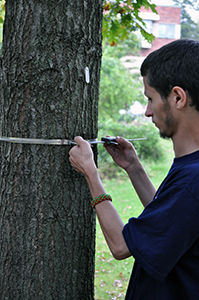An unlikely pairing of Penn State Brandywine Information Science and Technology student Jonathan Spross and Associate Professor of Earth Sciences Laura Guertin has resulted in a research project that could change the way scientists look at trees and climate change.
In March 2012, Guertin signed on to the Smithsonian Institution's Global Tree Banding Project, a global initiative encouraging scientists around the world to measure the growth of trees in their area from season to season. The result will be an international climate change database managed by the Smithsonian, which will contribute to a newly established global observatory of how tree growth responds to climate change.
With the help of campus Groundskeeper Charles Daly and now-graduate Aimee Capuzzi, who volunteered to work on the project before passing the buck to Spross after graduation, metal bands provided by the Smithsonian were placed on 10 trees across campus. Every two weeks, Capuzzi, and now Spross, measure the growth of each tree trunk using digital calipers, take photos, record the GPS coordinates of each tree and log the date and other pertinent data, such as temperature and precipitation. Currently, there are still nine trees in the study, as one lost its band early on, and since 2012, the students have collected close to 400 measurements.
"These data are not only contributing to a larger scientific effort but are providing information for our students to work with on campus, in our courses and in an authentic undergraduate research experience." Guertin explained. "One of my sabbatical projects is to create a website that will display the data for all of our students and other classrooms and teachers to access." Guertin, Spross and Capuzzi will also write and submit their first paper to the Journal of the Pennsylvania Academy of Sciences with their data analysis.
To ensure a diverse sampling, Daly helped the team of Brandywine scientists locate trees in a variety of environments, such as shaded versus sunny and secluded versus high traffic areas, as well as trees that are visited by a variety of different species of animals and insects.
Spross explained that their findings confirm tree growth is linked to seasonal fluctuations, with spring and fall showing signs of the most rapid growth, winter exhibiting minimal growth and steady growth in the summer.
"It is interesting to see the growth, the plateau and then the growth again," Guertin added. "It will be interesting to see if this trend continues!"
Though he had no previous interest in pursing science while in college, Spross said he's really enjoyed the project and is earning two credits per semester as an independent study. "It's been really fun and interesting," he said. "I've learned to keep a schedule and be more organized." He also said the experience opened up a whole new world to him as an IST major turned scientist.
For Guertin, the best part is seeing her students take ownership of a project that will have a global impact. She commended both Capuzzi and Spross on their strong work ethic and conceded she had to put a lot of trust in the students from the get-go. She is determined to continue the project and bring on new student scientists to collect the data until every last tree band falls off.
